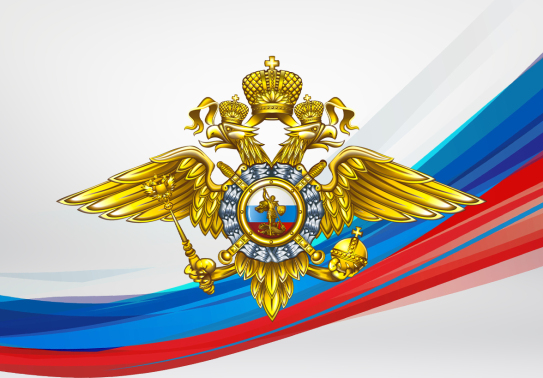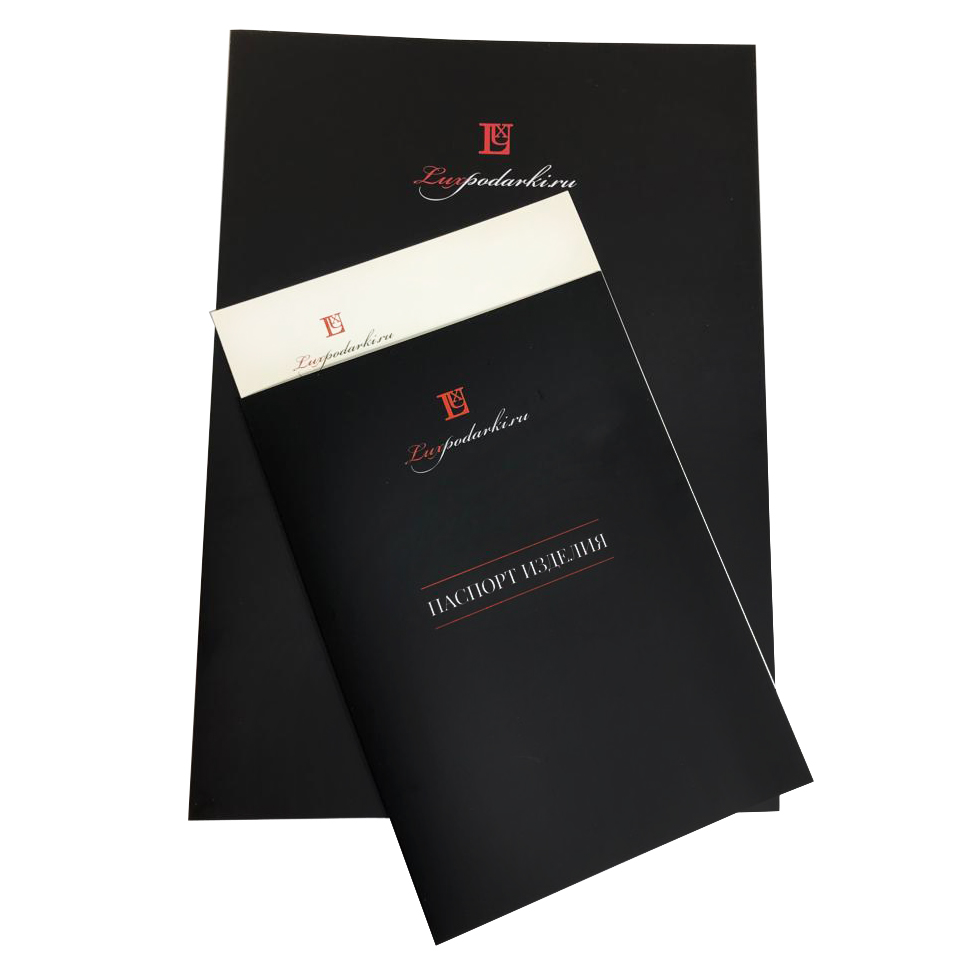Russian Tea Party
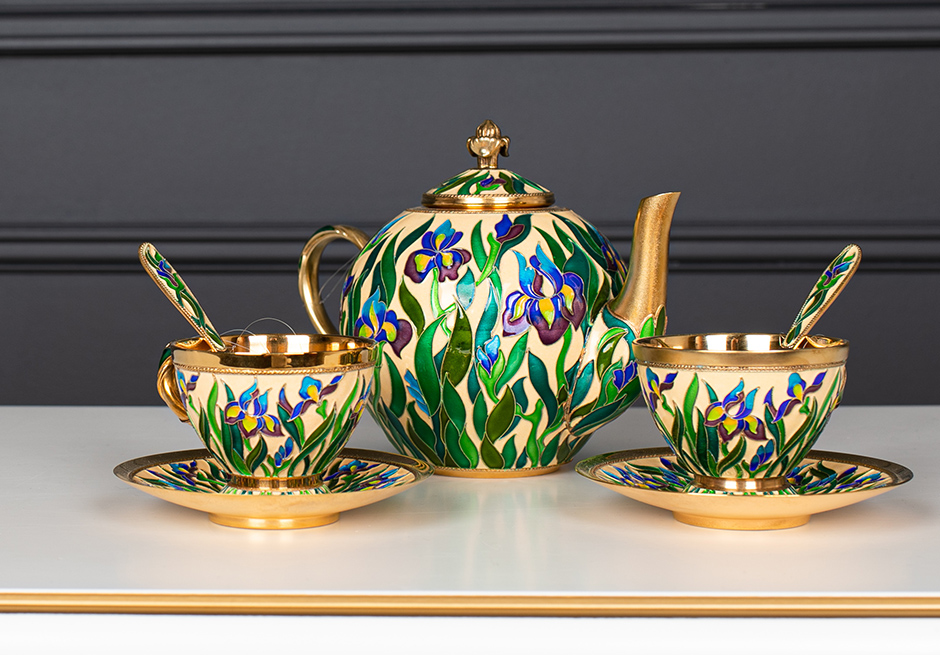
For a Russian person, tea drinking is a pacifying ritual that has been formed over the centuries. A shiny samovar, beautiful cups and saucers from grandma's set, fragrant honey and a generous snack — if you also set the table in nature and gather a pleasant company, all this acquires a special, almost mystical meaning. A spiritual tea ritual relaxes or, conversely, tones up, allows you to forget about problems, gives you a boost of energy and unity with the world...
Tea party with a Russian samovar
The main "hero" of the Russian—style tea ceremony is a samovar, a symbol of prosperity and family well-being. It was included in the bride's dowry, inherited and kept in the most prominent place in the house. There were up to 12 samovars in wealthy families!
A tea set with a samovar "Welcome" for 4 people will decorate your kitchen and dining room, give you many  joyful moments in communication with friends and loved ones. The samovar, tray and tea utensils are made of gilded brass and painted in the technique of Zlatoust engraving. Delicate enamel patterns and natural malachite give the tea collection a national flavor. Elegant and miniature porcelain cups are literally for a few sips, so you will have to fill them more often. In Siberian villages, guests were not allowed out of the house until they had drunk 10 cups of tea!
joyful moments in communication with friends and loved ones. The samovar, tray and tea utensils are made of gilded brass and painted in the technique of Zlatoust engraving. Delicate enamel patterns and natural malachite give the tea collection a national flavor. Elegant and miniature porcelain cups are literally for a few sips, so you will have to fill them more often. In Siberian villages, guests were not allowed out of the house until they had drunk 10 cups of tea!
The Daromir tea set made of carved birch bark with a samovar and a tray looks like a decoration for a Russian folk tale. But birch bark products in Slavic culture were a powerful family talisman. Birch bark protects the house from troubles and misfortunes, gives health, well-being and harmony.
The tea set "Russian feast", made in the Zlatoust style and decorated with lapis lazuli and enamels, looks very rich and picturesque. An exquisite samovar on a wooden stand surrounded by six elegant glasses on saucers with cup holders, once only aristocrats and merchants could afford. The first mention of samovars in historical chronicles dates back to the XVIII century, although in fact these household utensils appeared much earlier.
Teapots and topping-up: Russian traditions in tea drinking
The native "brother" of the Russian samovar is a teapot, which first appeared in China, and then became popular in Europe. The first Russian teapots were vessels from which sbiten was poured. Of course, they were inferior in their elegance to European dishes, but they were very practical and durable.
A bright porcelain teapot with underglaze painting in Italian paints looks elegant and cheerful, and its name is non—standard - Anna "Cap Cake". This is a topping kettle, which is used in the Russian tea tradition to dilute strong tea — it is usually filled with boiling water. An antique tea 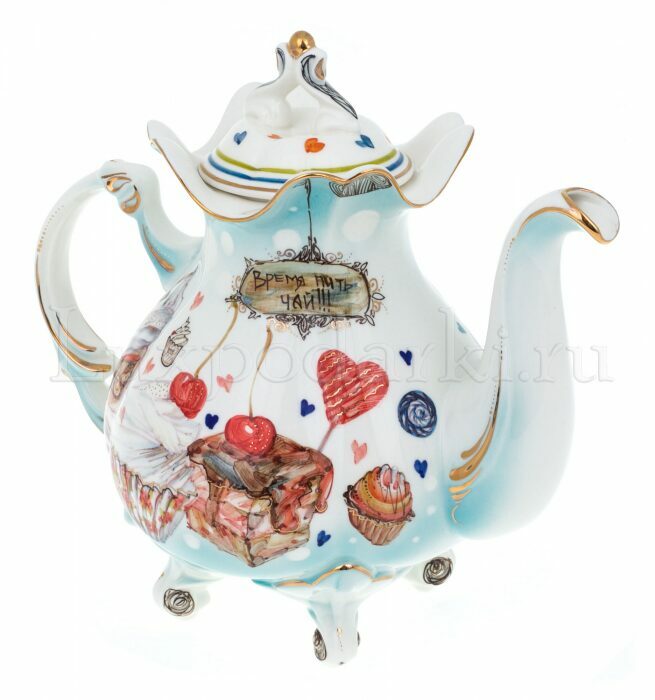 accessory on elegant legs, colorful and cheerful, decorated with drawings that make you want to pour tea and enjoy desserts.
accessory on elegant legs, colorful and cheerful, decorated with drawings that make you want to pour tea and enjoy desserts.
The aristocratic teapot "Alexandria" is made according to the museum model at the Lomonosov Porcelain Factory. It harmoniously combines the perfection of form and decoration. It is easy to imagine such dishes on the table in a noble house during a tea party, as well as a stylish teapot "Alexander III" with a berry pattern and a cherry border at the top. The Domed teapot made of bone china, decorated with a popular cobalt mesh, is a standard of sophistication and charm.
Fragrant tea from Russian cups
According to the Russian tradition, hot tea is poured from cups into saucers and carefully drunk, sucking the drink with your lips. That is why the saucers should be comfortable and roomy — as, for example, in the Spring tea set for 6 people. It is decorated with country—style patterns, and it has everything - tea cups and saucers, dessert plates, a teapot and a sugar bowl. By the way, sugar was not added to tea in those days, but was drunk side by side — it tastes better this way!
The Merchant tea set with cobalt underglaze painting in white, blue and light blue tones is ideal for a merchant-style tea ceremony. The homely composition is made in the form of a table with tea utensils, a merchant with a cup of tea in his hand and two elegant painted cups. The golden decor highlights the exquisite luxury of the dishes, which were probably taken out on big holidays, although in rich families they were used as everyday household utensils.
Any tea party will be decorated with silver tea cups and saucers made in the technique of Khokhloma painting. A colorful floral ornament splashing with gold on a black background looks fabulous and magical. It is 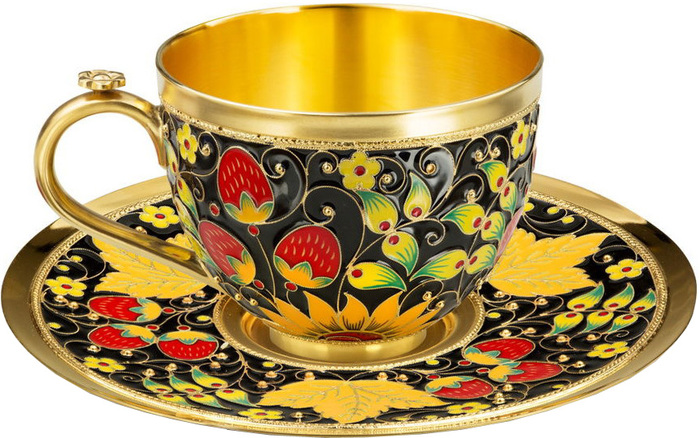 impossible to look away from a teapot with two tea pairs made of silver "Tenderness", decorated with Rostov finifty, they are so picturesque and spectacular. The secrets of this folk craft have been inherited by hereditary craftsmen for centuries, and it is impossible to copy the delicate finish patterns, no matter how hard you try.
impossible to look away from a teapot with two tea pairs made of silver "Tenderness", decorated with Rostov finifty, they are so picturesque and spectacular. The secrets of this folk craft have been inherited by hereditary craftsmen for centuries, and it is impossible to copy the delicate finish patterns, no matter how hard you try.
Cup holders as part of tea etiquette
Stylish cup holders appeared in the XVIII century, when new rules of etiquette were introduced in Russia. Women had to drink tea from porcelain cups, and men had to drink tea from glasses. In order not to get burned, the glasses were placed in special cup holders, which were decorated with initials and family coats of arms.
 A brass tea set with lapis lazuli, decorated with a Zlatoust engraving, could well have been on the table in the house of wealthy citizens. Glass glasses with embossed patterns, lapis lazuli decor on saucers and cup holders, gilded teaspoons — with such dishes, an ordinary tea party turns into a real holiday.
A brass tea set with lapis lazuli, decorated with a Zlatoust engraving, could well have been on the table in the house of wealthy citizens. Glass glasses with embossed patterns, lapis lazuli decor on saucers and cup holders, gilded teaspoons — with such dishes, an ordinary tea party turns into a real holiday.
Many tea gourmets use a French press instead of a teapot. This is very modern, and it greatly simplifies the brewing of a fragrant drink. Take a closer look at the tea set with a French press made of gilded brass from the masters from Zlatoust. These magnificent products are decorated with the coat of arms of Russia and will appeal to true patriots.
The cup holders "Hunting for wild boar and elk", decorated with relief images of wild animals made of brass, look very original. Admires the finest elaboration of details and the dynamics of the plot — it seems that the elk and wild boar are about to jump out of the thicket to the delight of the hunter. The amber cup holder "Zheleznodorozhny" is made in a completely opposite style — it seems too minimalistic, but this is an illusion. Natural amber embodies luxury, which is not always striking, especially if the color of the stone is quite restrained.
Not a single tea...
No Russian tea party was complete without pastries and sweets. Dried fruits, bagels, bagels, gingerbread, jam, honey, raisins, marshmallows, candied almonds, halva, cranberries, soaked apples, lemon and raspberry sugar — Russian desserts were always served on beautiful dishes. The candy bowl "Scarlet Flower", decorated with natural mother-of-pearl and fancy patterns of stained glass enamel, will decorate the tea table, and sweets in it will look very appetizing.
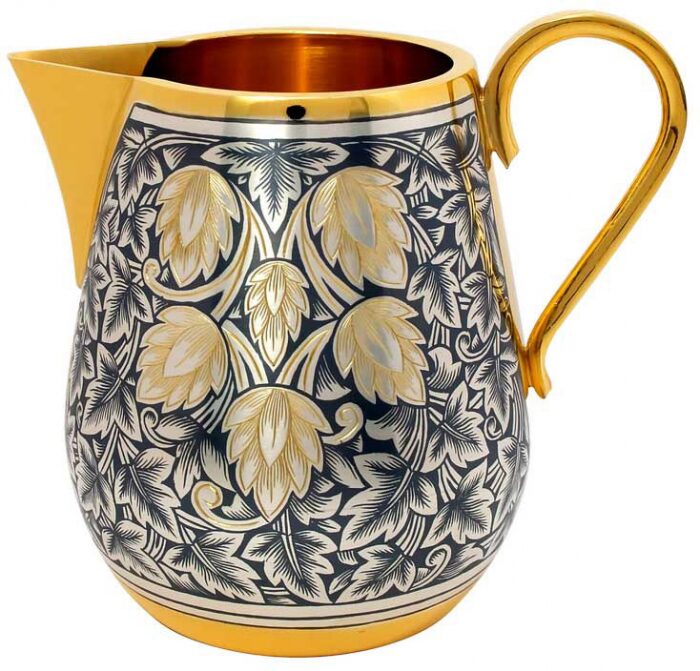 Our store has everything you need for a tea ceremony — a sugar bowl made of jasper in a natural green-brown palette, an elegant fruit bowl made of charoite with two bronze angels, an unusual crystal dish "With cones" the color of forest grass, a honey bowl with a whisk, complemented by enamel drawings and decorated with Zlatoust painting, a strainer for brewing "Berry" and silver milk jug "Hop", made in the technique of blackening on silver. But the most important thing in tea drinking is sincere company. As they said in Russia, tea is stronger if it is shared with a good friend.
Our store has everything you need for a tea ceremony — a sugar bowl made of jasper in a natural green-brown palette, an elegant fruit bowl made of charoite with two bronze angels, an unusual crystal dish "With cones" the color of forest grass, a honey bowl with a whisk, complemented by enamel drawings and decorated with Zlatoust painting, a strainer for brewing "Berry" and silver milk jug "Hop", made in the technique of blackening on silver. But the most important thing in tea drinking is sincere company. As they said in Russia, tea is stronger if it is shared with a good friend.
Check out our tea department! If you have chosen a souvenir, do not forget to decorate it with a gift inscription or initials. We wish you pleasant tea parties with friends and family!

